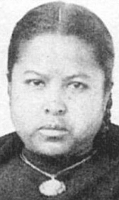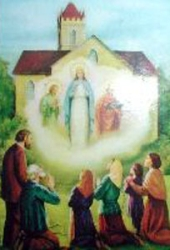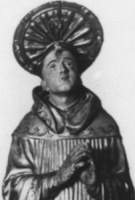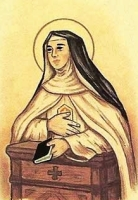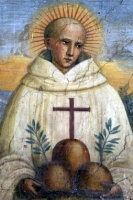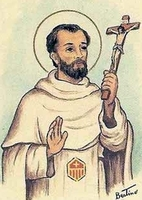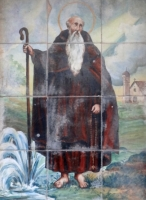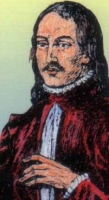St. Apollinaris Sidonius
Feastday: August 21
Birth: 430
Death: 489
Bishop and classical scholar. Caius Sollius Apollinaris Sidonius was born in Lugdunum, about 423. He was from a noble family and received a brilliant education in the classical style. Entering the military, he married Papianilla, the daughter of Avitus, who became emperor of the West in 455. Living at the imperial court, Apollinaris survived the deposition of Avitus in 456 and subsequently served as the chief senator and prefect of Rome from 468 to 469. He then retired to Gaul, where he carried on a vast correspondence that gives considerable insight into the political period. In 469, although unwilling and not yet a priest, Apollinaris was named bishop of Avernum. He was chosen because of his piety and because he was considered the only one capable of defending the people against the invading Goths, under Alaric. Apollinaris assumed the humble lifestyle of the bishopric and learned so much about ecclesiastical affairs that he was soon recognized as an authority. He opposed King Euric of the Goths in 474 and was exiled briefly. He was an outstanding orator and poet, and he introduced the days of public prayer called "Rogation Days." Twenty-four of his letters and poems survived and are a valuable resource on the period. Apollinaris is considered to be the last representative of the great classical culture of Rome which was being overrun by the Germanic invasions.
Gaius Sollius Modestus Apollinaris Sidonius, better known as Sidonius Apollinaris (5 November[1] of an unknown year, c. 430 – 481/490 AD), was a poet, diplomat, and bishop. Sidonius is "the single most important surviving author from fifth-century Gaul" according to Eric Goldberg.[2] He was one of four Gallo-Roman aristocrats of the fifth- to sixth-century whose letters survive in quantity; the others are Ruricius, bishop of Limoges (died 507), Alcimus Ecdicius Avitus, bishop of Vienne (died 518) and Magnus Felix Ennodius of Arles, bishop of Ticinum (died 534). All of them were linked in the tightly bound aristocratic Gallo-Roman network that provided the bishops of Catholic Gaul.[3] His feast day is 21 August.
Pope Saint Pius X
புனிதர் பத்தாம் பயஸ்
(St. Pius X)
257வது திருத்தந்தை:
(257th Pope)
இயற்பெயர்:
குயிசெப் மேல்ச்சியோர் ஸர்டோ
(Giuseppe Melchiorre Sarto)
பிறப்பு: ஜூன் 2, 1835
ரெய்சி, ட்ரேவிசோ, லம்பர்டி-வெனிஷியா, ஆஸ்திரிய பேரரசு
(Riese, Treviso, Lombardy-Venetia, Austrian Empire)
இறப்பு: ஆகஸ்ட் 20, 1914 (வயது 79)
அப்போஸ்தலர் மாளிகை, ரோம், இத்தாலி அரசு
(Apostolic Palace, Rome, Kingdom of Italy)
ஏற்கும் சமயம்:
ரோமன் கத்தோலிக்க திருச்சபை
(Roman Catholic Church)
முக்திபேறு பட்டம்: ஜூன் 3, 1951
திருத்தந்தை பன்னிரண்டாம் பயஸ்
(Pope Pius XII)
புனிதர் பட்டம்: மே 29, 1954
திருத்தந்தை பன்னிரண்டாம் பயஸ்
(Pope Pius XII)
நினைவுத் திருவிழா: ஆகஸ்ட் 21
பாதுகாவல்:
அட்லான்டா உயர் மறைமாநிலம்; தேஸ் மொயின்ஸ், ஐயோவா மறைமாநிலம்; புது நன்மை வாங்குவோர்; கிரேட் பால்ஸ்-பில்லிங்ஸ் மறைமாநிலம்; [கோட்டயம், இந்தியா மறைமாநிலம்; திருப்பயணிகள்; சான்டா லுசிஜா, மால்டா; ஸ்பிரிங் பீல்டு, மிசூரி மறைமாநிலம்; சம்போஙா, பிலிப்பைன்சு மறைமாநிலம்
திருத்தந்தை புனிதர் பத்தாம் பயஸ், கி.பி. 1903ம் ஆண்டு முதல் 1914ம் ஆண்டு வரை கத்தோலிக்க திருச்சபையின் 257-ஆவது திருத்தந்தையாக ஆட்சி செய்தவர் ஆவார். இவர் ஐந்தாம் பயஸுக்கு பின் புனிதர் பட்டம் பெற்ற திருத்தந்தையாவார். இவர் திருச்சபையின் கொள்கைகளுக்கு நவீனத்துவ விளக்கங்கள் அளிப்பதை எதிர்த்தார். பாரம்பரிய விளக்கங்களையே ஊக்குவித்தார். இவரின் மிகமுக்கிய செயல்பாடாக கருதப்படுவது, இவர் வெளியிட்ட திருச்சபை சட்ட தொகுப்பாகும். இவ்வாறு வெளியிடப்படுவது இதுவே முதல் முறையாம். இவர் கிறிஸ்தவ ஒழுக்கங்களை தனிமனித வாழ்விலும் கடைபிடிப்பதில் ஊக்குவித்தார். இவர் பிறந்த ஊரான ரெய்சி, இவரின் பொருட்டு பின்நாளின் ரெய்சி பியோ X (இத்தாலிய ஒளி பெயர்ப்பில் இவரின் பெயர்) என பெயர் மாற்றம் செய்யப்பட்டது.
இவர் மரியாளிடம் பக்தி கொண்டவராக விளங்கினார். இவர் “Ad Diem Illum” என்னும் தனது சுற்றறிக்கையில், "மரியாளின் வழியாக கிறிஸ்துவில் யாவற்றையும் புதுப்படைப்பாக்க" என்னும் தனது விருப்பத்தை வெளிப்படுத்தினார். இதையே தனது ஆட்சியின் குறிக்கோளுரையாகக் கொண்டார். கி.பி. 20ம் நூற்றாண்டில் திருத்தந்தையாக இருந்தவரில் பத்தாம் பயஸ் மட்டுமே அதிக தளப்பணி செய்தவராவார். இந்த அனுபவத்தாலேயே அவரவரின் சொந்த மொழியிலேயே மறைபரப்ப தூண்டினார்.
இவரின் தொண்டு உள்ளம் வியக்கத்தக்கது. கி.பி. 1908ல் நடந்த மெசினா நிலநடுக்கத்தில் பாதிக்கப்பட்டவர்களை, இத்தாலிய அரசு உதவி புரிய ஆரம்பிக்கும் முன்பே, தாமாகவே முன்வந்து திருத்தூதரக அரண்மனையில் தங்க வைத்தார். தம் குடும்பத்திற்கு எந்தவித உதவியும் பெறவில்லை. இவரின் மிகவிருப்பமான உடன் பிறந்தவரின் மகன் கடைசிவரை கிராமத்தில் பங்கு குருவாகவே இருந்தார். மற்ற மூன்று சகோதரிகளும் ஏழ்மையிலேயே வாழ்வைக் கழித்தனர். 'நான் ஏழையாக பிறந்தேன், ஏழையாக வாழ்ந்தேன், ஏழையாகவே சாக விரும்புகிறேன்' என அடிக்கடி சொல்வார். பலர் இவரின் மரணத்தின் பின்னர், இவரை புனிதரெனக் கொண்டாடி வெளிப்படையான வணக்கம் செலுத்தினர். இதனாலேயே இவரின் புனிதர் பட்ட நிகழ்வு விரைவில் நடந்தேறியது.
கி.பி. 1878ல் மறைமாவட்ட ஆயர் சனாலியின் மரணத்திற்குப் பின், மறைமாவட்டப் பேராலய உயர்நிலைக் குருக்கள் பேரவை இவரை (மற்றொரு ஆயர் நியமிக்கப் படும் வரை) அதன் தலைவராகத் தேர்ந்தெடுத்தது. கி.பி. 1878 டிசம்பர் முதல் ஜூன் 1880 வரை இப்பொறுப்பில் அவர் இருந்தார்.
கி.பி. 1880-க்கு பின் திரிவிசோ குருமடத்தில் ஆசிரியராக பணியாற்றினார்.
கர்தினாலாகவும் மூப்பராகவும்:
கி.பி. 1893ம் ஆண்டு, ஜூன் மாதம், 12ம் நாளன்று, பதின்மூன்றாம் லியோ இவரை கத்தோலிக்க கர்தினாலாக உயர்த்தினார். சான் பெர்னாதோ அலே தெர்மியின் (பட்டம் சார்ந்த) கர்தினால் குருவாகவும், மூன்று நாட்களுக்கு பின் வெனிசின் மூப்பராகவும் திருத்தந்தை அறிவித்தார். இத்தாலிய அரசுடன் திருச்சபைக்கு இருந்த மனக்கசப்பால் கி.பி. 1894ம் ஆண்டு வரை பொறுப்பேற்க இயலவில்லை.
திருப்பீட தேர்வு:
கி.பி. 1903ம் ஆண்டு, ஜூலை மாதம், 20ம் நாளன்று, பதின்மூன்றாம் லியோ காலமானார். அதன் பின் கூடிய திருப்பீடத்தேர்வில் (en:Papal Election) கர்தினால் சார்தோ 1903ம் ஆண்டு, ஆகஸ்ட் மாதம், 4ம் நாளன்று, திருத்தந்தையாக தேர்த்தெடுக்கப்பட்டார். இவர் தன் ஆட்சிப்பெயராக பத்தாம் பயஸை தெரிவு செய்தார். 1903ம் ஆண்டு, ஆகஸ்ட் மாதம், 9ம் தேதி, முடிசூட்டு விழா நடந்தது.
திருப்பீட ஆட்சி:
இவர் கிறிஸ்தவத்தின் அடிப்படைவாத கொள்கையையுடையவர். இதனையே தம் ஆட்சிக்காலத்திலேயும் கையாண்டார். இவர் முடி சூட்டப்பட்ட தினத்தன்று இவரின் கழுத்தில் இருந்த சிலுவை முலாம் பூசப்பட்டது என்பதை அறிந்த பணியாளர்கள் அதிர்ந்தனர். ஆனால் இவர் அமைதியாக தன்னிடம் வேறு சிலுவை இல்லை எனக்கூறி அதனையே அணிந்து வந்தார். திருத்தந்தை எட்டாம் அர்பனால் கொண்டுவரப்பட்ட பழக்கமான, திருத்தந்தை தனியாக உணவருந்துதலை இவர் அழித்தார். இவர் தன் நண்பர்களைத் தன்னோடு உணவருந்த அழைப்பு விடுத்தார்.
இவர் சிறுவர்களிடம் தனிப்பட்ட அன்பு செலுத்தினார். சிறுவர்களைக் கவர எப்போதும் தன்னுடன் இனிப்புகளை எடுத்துச் செல்வார். இவர் பங்குகளில் சிறுவர்களுக்கான மறைக்கல்வியின் முக்கியத்துவத்தை எடுத்துரைத்து, சிறுவர்களை ஆன்மிக இருளிலிருந்து வெளிக்கொணர முயன்றார்.
திருச்சபை சீர்திருத்தங்களும் இறையியலும்:
கிறிஸ்தியல் மற்றும் மரியாலியலில்:
பத்தாம் பயஸ் தினசரி நற்கருணை வாங்குவதை ஊக்குவித்தார். 1904ல் வெளியிட்ட சுற்றுமடலில் (Encyclical Ad Diem Illum), "கிறிஸ்துவில் எல்லாவற்றையும் புனிதமாக்குவதில்" மரியாளுக்கு இருக்கும் பங்கினை எடுத்தியம்பினார். நாம் அனைவரும் மரியாளின் ஆன்மிகப் பிள்ளைகளாயிருப்பதால் அவருக்கு அன்னைக்குரிய வணக்கம் செலுத்தப்பட வேண்டும் என்றார். வாக்கு மனிதர் ஆனார் என கிறிஸ்துவைப்பற்றி விவிலியம் கூறுகின்றது. ஆனால் மனு உருவான அவ்வாக்கிற்கு உடல் கொடுத்ததால் அவர் கிறிஸ்துவின் அன்னையாகிறார். கிறிஸ்துவின் மறைஉடலான திருச்சபை, கிறிஸ்துவின் மனித உடலிலிருந்து வேறுபடுத்திப் பார்க்க இயலாது, ஆகவே மரியாள் திருச்சபையின் ஆன்மீக அன்னை மட்டுமல்ல, அவள் உண்மையான அன்னையும் கூட என்றார்.
திருச்சபை சட்டங்களில் சீர்திருத்தம்:
1904ம் ஆண்டு, மார்ச் மாதம், 19ம் தேதி, திருச்சபையின் சட்டத்தொகுப்பை உலகம் முழுமைக்கும் ஒரே சட்டத்தொகுப்பாக்கும்படி கர்தினால் குழாமின் ஆணையம் ஒன்றை வடிவமைத்தார். இவருக்கு முன் உலகம் முழுமைக்கும் ஒரே திருச்சபை சட்டத்தொகுப்பு இருந்ததில்லை. இவருக்குப் பின் திருத்தந்தையானவர்களுள் இருவர் (பதினைந்தாம் பெனடிக்ட் மற்றும் பன்னிரண்டாம் பயஸ்) இவ்வாணையத்தில் இருந்தனர். இவ்வாணையம் தன் பணியை பதினைந்தாம் பெனடிக்டின் ஆட்சியில் 1917ம் ஆண்டு, மே மாதம், 27ம் நாளன்று, நிறைவு செய்தது. அவை, 1918ம் ஆண்டு, மே மாதம், 19ம் நாளன்று துவங்கி, 1983ம் ஆண்டின் திருவருகை காலம் வரை நடைமுறையில் இருந்தது.
திருச்சபை சட்டத்தில் சீர்திருத்தம்:
பத்தாம் பயஸ் திருத்தந்தையின் திருப்பீடத்தின் கீழ் வரும் ஆட்சித்துறைகளை (Roman Curia) சீரமைத்தார். குறிப்பாக குருத்துவக் கல்லூரிகளை மேல்பார்வையிடும் ஆயர்களின் பணியைப் புதிய சட்டங்களால் 'Pieni L'Animo' என்னும் சுற்றுமடலின் மூலமாக திருத்தினார். பல சிறிய குருத்துவக் கல்லூரிகளை ஒன்றிணைத்து பெரிய குருமடம் உருவாக செய்தார். புதிய குருத்துவ கல்வி முறையை உருவாக்கினார். பொதுப்பணித்துறை நிறுவனங்களை குருக்கள் தலைமை தாங்கி நடத்த தடை விதித்தார்.
வாழ்நாளில் செய்ததாக கூறப்படும் புதுமைகள்:
பத்தாம் பயஸ் தன் வாழ்நாளிலேயே பல புதுமைகளை செய்துள்ளார் என்பர். முடக்கு வாதம் உற்ற குழந்தை இவர் தூக்கியதால் நலம் பெற்றது என்பர். மூளைக் காய்ச்சல் உடைய இரண்டு வயது குழந்தையின் பெற்றோர் இவரை செபிக்கும்படி கடிதம் எழுதினர். இரண்டு நாட்களில் குழந்தை குணமானது என்பர்.
காச நோயுற்றிருந்த எர்னஸ்தோ ருபின் (பின்நாளின் பலேர்மோவின் பேராயர்) இவரைக்கண்ட போது, ருபின் குணமடைந்து விடப்போவதாகவும், அதனால் குருத்துவக் கல்வியை தொடர மீண்டும் குரு மடத்திற்கு செல்ல அறிவுறுத்தியதாக குறியுள்ளார்.
பிற செயல்கள்:
பத்தாம் பயஸ் பத்து பேருக்கு முக்திபேறு பட்டமும், நான்கு பேருக்கு புனிதர் பட்டமும் அளித்துள்ளார். பத்தாம் பயஸ் 16 திருத்தூது மடல்களை வரைந்துள்ளார்; அவற்றுள் “Vehementer nos” என்னும் மடல் ஃபெப்ரவரி 11, 1906, அன்று வெளியிடப்பட்டதில் 1905ம் ஆண்டு ஃபிரான்ஸ் நாட்டின் அரசு சமயம் பிரிவினை சட்டத்தைக் கண்டித்தார்.
இறப்பும் அடக்கமும்:
1913ல், புகைப்பழக்கம் உள்ள பத்தாம் பயஸ், மாரடைப்பால் உடல் நலம் குன்றினார். 1914ல் வின்னேற்பு அன்னை திருவிழாவன்று (15 ஆகஸ்ட்) இவர் திரும்பவும் நோய்வாய்பட்டார். முதலாம் உலகப் போர் துவங்கியதால் மனம் பாதிக்கப்பட அவர், 20 ஆகஸ்ட் 1914 அன்று இயற்கை எய்தினார். பின்பு இவர் புனித பேதுரு பேராலயத்தில் அடக்கம் செய்யப்பட்டார்.
இவருக்கு முன்பு வரை திருத்தந்தையரை அடக்கம் செய்யும் முன், உடல் பதனிடும்போது உள் உறுப்புகளை நீக்குவர். ஆனால் இவர் இதை தடை செய்தார். இன்றுவரை இத்தடை அமலில் உள்ளது.
Also known as
• Giuseppe Melchior Sarto
• Giuseppe Melchiorre Sarto
• Giuseppe Sarto
• Joseph Sarto
• Pope of the Blessed Sacrament
Profile
Son of Giambattista Sarto, a village cobbler, and Margherita Sanson, living an impoverished childhood as one of eight children. Baptized on 3 June 1835. Confirmed on 1 September 1848. He early felt a calling to the priesthood. Studied at the seminary of Padua, Italy, and was known as an exceptional student. Ordained by Blessed Giovanni Antonio Farina on 18 September 1858. Chaplain at Tombolo from 1858 to 1867. Archpriest of Salzano from 1867 to 1875. Canon of the Treviso cathedral chapter in 1875. Rector of the Treviso seminary and its spiritual director for nine years. Primicerius of the cathedral in 1879. Chancellor of the diocese of Treviso. Vicar capitular from December 1879 to June 1880. Bishop of Mantua, Italy on 10 November 1884. Assistant at the Pontifical Throne on 19 June 1891. Created cardinal-priest of Saint Bernardo alle Terme on 12 June 1893. Patriarch of Venice on 15 June 1893. Chosen 257th pope in 1903, taking the name Pius X.
Issued decrees on early Communion (age 7 instead of 12 or 14 as previously). Destroyed the last vestiges of Jansenism by advocating frequent and even daily Communion. Reformed the liturgy, promoted clear and simple homilies, and brought Gregorian chant back to services. Revised the Breviary, and teaching of the Catechism. Fought Modernism, which he denounced as "the summation of all heresies". Reorganized the Roman curia, and the other administrative elements of the Church. Worked against the modern antagonism of the state against the Church. Initiated the codification of canon law. Promoting Bible reading by all the faithful. Supported foreign missions. His will read: "I was born poor; I lived poor; I wish to die poor."
Born
2 June 1835 at Riese, diocese of Treviso, Venice, Austria (now Italy) as Giuseppe Melchiorre Sarto
Papal Ascension
• elected 4 August 1903
• installed 9 August 1903
Died
• 21 August 1914 at Vatican City from natural causes aggravated by worries over the beginning of World War I
• buried under the altar of the chapel of the Presentation, Saint Peter's basilica
Canonized
29 May 1954 by Pope Pius XII
Patronage
• first communicants
• pilgrims
• 7 dioceses
Blessed Ladislaus Findysz
Also known as
Wladyslaw Findysz
Profile
Born to pious peasants, the son of Stanislaus Findysz and Apollonia Rachwal. Received his early education from the Felician Sisters. Joined the Marian Solidality as a young student. Entered the major seminary in Przemysl in the autumn of 1927. Spiritual student of Blessed John Balicki. Ordained on 19 June 1932.
Assistant parish priest at Boryslaw, Poland (in modern Ukraine) on 1 August 1932. Assistant parish priest at Drohobycz, Poland (in modern Ukraine) on 17 September 1935. Assistant parish priest at Strzyzów, Poland on 1 August 1937. Assistant parish priest at Jaslo, Poland on 10 October 1940. Parish administrator and then parish priest in Nowy Zmigród beginning on 8 July 1941.
On 3 October 1944 Ladislaus and the rest of the town were expelled by the retreating German army. Having survived the oppression of the Nazis, he returned on 23 January 1945 to rebuild the parish, and to care for war refugees under the oppression of the Communists. He saved several Greek Catholic families who were being persecuted and exiled by the Communists. From 1946 until his death he was under surveillance of the secret police; that same year he was recognized for his good work by being declared an honorary canon. Ordered to stop teaching the catechism in 1952. In order to hinder his work, in 1952 and 1954 he was ordered to live outside the area of his parish. Vice-dean of the Nowy Zmigród deanery in 1957; dean in 1962.
In 1963 he started the Conciliar Works of Charity, a letter writing campaign to parishioners to exhort them to return to the Church, and to spread the word of the reforms of Vatican II. The Communists took a very dim view of this work, and on 25 November 1963 Father Ladislaus was arrested and imprisoned in the Rzeszów Castle, two months after major surgery to remove Ladislaus' thyroid gland. A standard show trial was conducted on 16 and 17 December 1963, and Ladislaus was given a 30 month sentence for the crime of "forcing" religion on his parishioners. This was followed by (also standard) series of published slanders and lies to discredit Ladislaus while he was being abused and starved in prison. Transferred to the central prison hospital on 25 January 1964, his health broken, and suffering from cancer of the esophagus. Surgery was postponed, and Ladislaus was permitted to suffer and deteriorate. Released from prison to his parish, Nowy Zmigród, on February 1964 due to his health, but civilian doctors proclaimed his tumors inoperable. Martyr.
Born
13 December 1907 in Kroscienko Nizne, near Krosno, Poland
Died
• morning of 21 August 1964 of cancer of the esophagus in the presbytery of Nowy Zmigród, Poland
• buried the same day in the parish cemetery
Beatified
• 19 June 2005 by Pope Benedict XVI
• recognition celebrated by Cardinal Jozef Glemp in Pilsudski Square, Warsaw, Poland
• the Cause for canonization began on 27 June 2000, the first Cause from the diocese of Rzeszów
• beatification approved on 20 December 2004 by Pope John Paul II
• first successful cause for beatification of a martyr of the Communist persecution in Poland
• recognition originally scheduled for 24 April 2005, but delayed due to the death of Pope John Paul II
Blessed Jacinto Blanch Ferrer
Profile
The son of José Blanch Bosch, a secretary, and Maria Ferrer Raurell, Jacinto was baptized on the day of his birth in his parish church of Santa Maria. His was a large and pious family; all his siblings would enter religious life, five of them as Claretian Missionaries. He made his First Communion at age 12, and entered the Claretian Missionaries' novitiate on 21 July 1884 in Vic, Spain at age 16. He studied in Vic, then Santo Domingo de la Calzada, and made his profession on 18 September 1885. Ordained a priest in the diocese of Zaragoza, Spain on 12 March 1892. As a seminarian, Jacinto had not been noted for scholarship, but was an immensely practical young man. He was assigned to teach Latin, and soon developed the speaking skills to preach in a series of Spanish cities for several years.
In the early 20th century, anti–Catholic violence broke out in Spain. Father Jacinto convinced some local nuns to wear street clothes instead of their habits in order to work in the community without persecution. He conducted a covert ministry in private homes for those who feared making their faith public, and he mixed with anti–Catholic mobs to talk them down from burning churches. His church and community house in Barcelona were burned in 1909. Jacinto was made superior of the community, and oversaw its reconstruction from 1911 through 1913. Superior of the Claretian community in Sallent, Spain in 1920 where he oversaw re-construction of their entire infrastructure.
In addition to a strong devotion to the Eucharist, the Blessed Virgin Mary and the Rosary, Father Jacinto was a student and devotee of Father Anthony Mary Claret, the founder of the Claretian Missionaries. He served as Vice-Postulator the Cause for Canonization of Saint Anthony Mary Claret and Father Francesc Crusats Franch from 1916 to 1936, and he published a bibliographic study of Father Claret.
When the Spanish Civil War began in earnest, Father Jacinto moved to the house of Don Eugenio Bofill from which he continued to conduct his covert ministry, celebrating Mass in private homes, receiving other Claretians for instruction, hearing Confessions, teaching catechism, and leading groups to pray the Rosary. On 17 August 1936, fearing his work and visitors would draw attention to the Bofill family, he moved out; he was seized by the militia on 19 August. We have no record of his last two days, but he was executed on 21 August for the crime of being a priest. Martyr.
Born
27 April 1868 in Vilanova de Sau, Barcelona, diocese of Vic, Spain
Died
• shot on 21 August 1936 in Pedrales, Barcelona, Spain
• interred in a niche in the Bofill family mausoleum in the All Saints cemetery
• his bones were later thrown into a common grave, making identification or recovery of relics impossible
Beatified
• 21 October 2017 by Pope Francis
• beatification recognition celebrated in the Basilica of Sagrada Familia in Barcelona, Spain, presided by Cardinal Angelo Amato
Blessed Victoire Rasoamanarivo
Profile
Daughter of Rainiandriantsilavo and Rambahinoro. Raised by her paternal uncle, Rainimaharavo, the commander-in-chief of the Malagasy army, the girl grew up in the animist faith of her ancestors. She began attending a Catholic school at age 13 and was immediately drawn to the faith. A convert, baptized on 1 November 1863, taking the name Victoire. A change in the national politics led to antipathy to the French and to Catholics; Victoire's family, being part of the ruling class, put her in a Protestant school and threatened to make her an outcast if she held to her new faith, but she would not change. Victoire felt drawn to religious life, but her family arranged a marriage for her to Ratsimatahodriaka, a cousin and leading figure in the military; they were wed on 13 May 1864. Her new husband was a violent, womanizing drunk, and all of Victoire's friends urged her to divorce him; she refused, saying that marriage was a sacrament and could not be broken, and instead she prayed for his conversion.
In 1883 the political situation in Madagascar turned forcefully against the French. All foreign missionaries, which included all priests, were ordered out of the country; Catholic schools and churches were ordered closed, Catholic gatherings were outlawed, and all Catholics were ordered to renouce the Church or be considered traitors. The faithful ignored the orders, held prayer services in boarded up churches, catechized new converts, and did it all peacefully and without a priesthood. Victoire helped lead and support the movement, keeping schools open, sometimes being the first into a church, shaming the police guards into letting the Christians enter. During 1885 peace was established between France and Madagascar, and on 7 March 1886 the missionaries were allowed to return; they found the faith alive and growing.
Victoire was widowed in in 14 March 1888, her husband asking forgiveness and being baptized on his death bed. She devoted the rest of her life to caring for the poor, the sick and the imprisoned, with all her free time spent in prayer.
Born
1848 in Antananarivo, Madagascar as Rasoamanarivo
Died
21 August 1894 in Anatanarivo, Madagascar
Beatified
30 April 1989 by Pope John Paul II
Saint Abraham of Smolensk
ஸ்மோலென்ஸ்க் நகர் புனிதர் ஆபிரகாம்
(St. Abraham of Smolensk)
ரஷிய துறவி மற்றும் குரு:
(Russian Monk and Priest)
பிறப்பு: கி.பி. 1150
ஸ்மோலென்ஸ்க், ரஷியா
(Smoensk, Russia)
இறப்பு: கி.பி. 1222
ஸ்மோலென்ஸ்க், ரஷியா
(Smoensk, Russia)
ஏற்கும் சமயம்:
ரோமன் கத்தோலிக்க திருச்சபை
(Roman Catholic Church)
கிழக்கு மரபுவழி திருச்சபை
(Eastern Orthodox Church)
புனிதர் பட்டம்: கி.பி. 1549
திருத்தந்தை மூன்றாம் பவுல்
(Pope Paul III)
நினைவுத் திருவிழா: ஆகஸ்ட் 21
பாதுகாவல்:
ஸ்மோலென்ஸ்க் (Smoensk)
புனிதர் ஆபிரகாம், ஒரு ரஷிய துறவியும் குருவும் (Russian Monk and Priest) ஆவார். “பொகாரோடிட்ஸ்காஜா” கான்வென்ட்டில் (Bogoroditzkaja convent) வசித்துவந்த இவர், அற்புதங்கள் புரிபவராக கருதப்பட்டார். விரிவான பிரசங்கங்களிலும், விவிலிய ஆய்வுகளிலும் ஈடுபட்டிருந்த இவர், மங்கோலிய ரஷியாவுக்கு முந்தைய (Pre-Mongol Russia) முக்கிய பிரமுகராக கருதப்படுகிறார்.
இப்புனிதர், கி.பி. 1150ம் ஆண்டு அல்லது 1172ம் ஆண்டில் பிரபுக்களுக்கு பிறந்ததாக கூறப்பட்டது. சிறு வயதிலேயே அனாதையான இவர், இவ்வுலக வாழ்க்கையை கைவிட்டு, மிகவும் கடினமான மற்றும் எளிய ஆன்மீக வாழ்க்கையை தேர்வு செய்ய முடிவு செய்தார். அவர் மனதில் கண்டிப்பு மற்றும் போர்க்குணமிக்க ஒரு மனிதராக விவரிக்கப்படுகிறார். இறுதி நியாயதீர்ப்பினை தமது மனதில் இருத்தியிருந்த இவர், அதனை பிறர் மனதிலும் இருத்த முயற்சித்தார். நோயுற்றவர்களுக்காகவும், கஷ்டபட்டவர்களுக்காகவும் பணிபுரிந்த அவர், உண்மையிலேயே விசுவாசமுள்ளவர்களுள் பிரபலமடைந்திருந்தார். அவருடைய உதவிக்காகவும் ஆலோசனைக்காகவும் அவரிடம் வருகிறவர்களுடன் அவர் மென்மையாக நடந்துகொண்டார். அவரது வெற்றிகள்மீது பொறாமை கொண்டிருந்த பிற குருமார்களோடு அவர் குறைவாகவே பிரபலமடைந்திருந்தார். பிற குருக்களிடையே இருந்த இந்த பதற்றம், அவருக்கு எதிரான பல தார்மீக மற்றும் இறையியல் குற்றச்சாட்டுகளுக்கு வழிவகுத்தது. இதன்காரணமாக, உள்ளூர் ஆயர் இவர் மீது நடவடிக்கை எடுத்து, இவரை பிரசங்கிக்க தடை விதித்தார். இதன் காரணமாக, இவர்மீது எப்போதும் சந்தேகம் கொண்டிருந்த குருக்களைத் தவிர்த்து, இவருக்கு நண்பர்கள் எவரும் இல்லாது போயினர்.
பின்னர், இவருக்கு எதிரான வழக்கை மீண்டும் கையிலெடுத்த உள்ளூர் ஆயர், இவர் மீதிருந்த அனைத்து குற்றச்சாட்டுக்களிலிருந்தும் இவரை விடுவித்தார். பின்னர், அப்பகுதியிலுள்ள கடவுளின் அன்னையின் சிறிய மற்றும் வறிய பள்ளியின் மடாதிபதியாக அவரை நியமித்தார்.
தமது மீதமுள்ள வாழ்க்கையை அங்கேயே வாழ்ந்த இப்புனிதர், கி.பி. 1222ம் ஆண்டு, மரித்தார்.
Also known as
• Avraamii
Profile
Born wealthy and orphaned young. When he was old enough to choose for himself, he gave away his fortune, and became a monk at the Bogoroditskaya monastery. Bible scholar, priest, and noted preacher. A stern and forceful man, his sermons concerned the Day of Judgement, and he lived his life as though he were about to be judged. He was very popular among the laity, gentle and ever concerned with the sick, the abused, and the troubled. However, it was a different matter among the clergy, many of whom were openly jealous or hostile toward him, and with the wealthy laity who opposed his teaching on poverty, an austere life, and the emptiness of worldly wealth. His abbot was pressured by local authorities, and he ordered Abraham to stop preaching.
To escape the disturbance, Abraham withdrew from the monastery, and joined the monks of the Holy Cross. He made no friends there, either, and in order to silence him some of his critics brought charges of moral and theological errors, heresy and immorality against him. He was acquitted in his first trial, so he was tried again. When he was acquitted again, he was ordered back to the Bogoroditskaya monastery, stripped of his priestly functions, and for five years he lived under a cloud of suspicion and disciplinary orders.
During a time of drought, the people demanded that he be reinstated as the hard times made them crave the intervention of an obviously holy man; the bishop re-opened his investigation, and this time Abraham was cleared of all charges. Legend says that Abraham then prayed for the city, and had not even returned to his cell in the monastery before it started to rain.
Appointed abbot of the small, impoverished Mother of God monastery in Smolensk, he lived the rest of his life in quiet prayer, supervising his house and receiving visitors, but declining to preach for fear of causing dissension in the faithful. His biography was written by one of his brother monks, and has survived to today.
Born
12th century at Smolensk, Russia
Died
c.1222 at Smolensk, Russia of natural causes
Canonized
1549 by Pope Paul III
Our Lady of Knock
Occurred
Thursday 21 August 1879 at 8pm
Status
devotion approved by Archbishop Thomas P Gilmartin, Archdiocese of Tuam, Ireland in 1936
Description
Our Lady, Saint Joseph and Saint John the Evangelist appeared in a blaze of light at the south gable of Saint John the Baptist Church, Knock, County Mayo, Ireland. They appeared to float about two feet above the ground, and each would occassionally move toward the visionaries, and then away from them. The Blessed Virgin Mary was clothed in white robes with a brilliant crown on her head. Where the crown fitted to her brow, she wore a beautiful full-bloom golden rose. She was praying with her eyes and hands raised towards Heaven. Saint Joseph wore white robes, stood on Our Lady's right, and was turned towards her in an attitude of respect. Saint John was dressed in white vestment, stood was on Mary's left, and resembled a bishop, with a small mitre. He appeared to be preaching and he held an open book in his left hand. Behind them and a little to the left of Saint John was a plain altar on which was a cross and a lamb with adoring angels. The apparition was witnessed by fifteen people. Miraculous healings were reported soon after the area, and it is now a major pilgrimage destination.
Patronage
Ireland
Blessed Bruno Zembol
Also known as
• Jan Zembol
• Johannes Zembol
Additional Memorial
12 June as one of the 108 Martyrs of World War II
Profile
Franciscan friar at the monastery in Chelm Lubelski, Poland, taking the name Bruno. Arrested for his faith by the Nazis in November 1939 and sent to the Dachau concentration camp which had a special unit for dealing with imprisoned Catholic clergy. Bruno spent his time in the camp ministering to other prisoners. One of the 108 Martyrs of World War II.
Born
7 September 1905 in Letownia, Malopolskie, Poland as Jan Zembol
Died
beaten to death on 21 August 1942 in the Dachau concentration camp, Oberbayern, Bavaria, Germany
Beatified
13 June 1999 by Pope John Paul II in Warsaw, Poland
Saint Gracia of Lérida
புனித கிரேஸ் (அ) கிராசியா (-1180)
ஆகஸ்ட் 21
இவர் தற்போதைய ஸ்பெயின் நாட்டில் உள்ள லெரிதா என்ற இடத்தைச் சார்ந்தவர். இவரது தந்தை லெரிதாவை ஆண்டு வந்த கலிபா (அ) மன்னர் அல்மான்ஜர் என்பவர் ஆவார் .
இவருக்குப் பெர்னார்ட் மற்றும் அல்மான்ஜர் என்று இரண்டு சகோதரர்களும், மரியா என்ற சகோதரியும் இருந்தனர். பிறப்பால் இஸ்லாமியரான இவர் தன் சகோதரர் பெர்னார்ட் மூலம் கிறிஸ்துவை ஏற்றுக் கொண்டார். இவரைத் தொடர்ந்து இவரது சகோதரியும் தந்தையும் கிறிஸ்துவை ஏற்றுக் கொண்டு, உண்மையான கிறிஸ்தவர்களாக வாழ்ந்து வந்தார்கள்.
இச் செய்தி இவரது மற்றொரு சகோதரரான அல்மான்ஜருக்குத் தெரியவர, அவர் இவரையும் இவரது சகோதரர், சகோதரி, தந்தை என நான்கு பேரையும் பற்றி மூர் இனத்தவரிடம் சொல்ல, அவர்கள் இவர்களைக் கொலைக் செய்தார்கள்.
இவ்வாறு கிரேஸ் (அ) கிராசியா தன்னுடைய இன்னுயிரைத் தந்து இயேசுவுக்குச் சான்று பகர்ந்தார்.
Also known as
Grace, Zaida
Profile
Daughter of Almanzor, Muslim caliph of Lerida, Catalonia. Sister of Saint Bernard and Saint Maria. Convert, brought to the faith by her brother Bernard. The three tried to convert their brother Almanzor, who turned them over to Moorish authorities. Martyr.
Born
at Lerida, Catalonia (in modern Spain) as Zaida
Died
c.1180
Patronage
Alcira, Valencia, Spain
Saint Maria of Lérida
Also known as
• Mary of Lérida
• Zoraida of Lérida
Profile
Daughter of Almanzor, Muslim caliph of Lerida, Catalonia in modern Spain. Sister of Saint Bernard of Lérida and Saint Grace of Lérida. Convert, brought to the faith by her brother Bernard. The three tried to convert their brother Almanzor, who turned them over to Moorish authorities. Martyr.
Born
at Lérida, Catalonia,Spain as Zoraida
Died
martyred c.1180
Patronage
Alcira, Valencia, Spain
Saint Bernard of Lérida
Also known as
Achmed
Profile
Son of Almanzor, Muslim caliph of Lerida, Catalonia. Brother of Saint Mary and Saint Grace. Convert. Benedictine Cistercian monk at Poblet, taking the name Bernard. With his sisters, he tried to convert his brother Almanzor, who turned them over to Moorish authorities. Martyr.
Born
at Lerida, Catalonia (in modern Spain) as Achmed
Died
c.1180
Patronage
Alcira, Valencia, Spain
Saint Bassa of Edessa
Profile
A devout Christian woman married to a pagan priest. Mother of Saint Theogonius, Saint Agapius and Saint Fidelis. Martyred in the persecutions of Diocletian. She was forced to watch her three sons be executed first; she prayed for them and encouraged them to not abandon their faith.
Died
c.304 in Edessa, Syria
Saint Giuse Ðang Van Viên
Also known as
Joseph
Additional Memorial
24 November as one of the Martyrs of Vietnam
Profile
Priest in the apostolic vicariate of East Tonkin. Martyr.
Born
c.1787 in Tiên Chu, Hung Yên, Vietnam
Died
beheaded on 21 August 1838 in Bay Mau, Hanoi, Vietnam
Canonized
19 June 1988 by Pope John Paul II
Saint Luxorius of Sardinia
Also known as
Lussurio
Profile
Christian soldier in the imperial Roman army. Comforted Saint Cisellus and Saint Camerinus after the boys had been sentenced to death. Martyred in the persecutions of Diocletian.
Died
beheaded in 303 in Sardinia, Italy
Saint Anastasius Cornicularius
Profile
Military tribune, a position known as cornicularius. He was so impressed and moved by the courage of Saint Aeapitus under torture for his faith that he announced, "The God of Aeapitus is my God." He was immediately arrested and executed by order of Aurelian. Martyr.
Died
274 at Salone, Italy
Saint Cyriaca
Also known as
Dominica
Profile
Wealthy married woman in Rome, Italy. Widowed, she spent her fortune sheltering persecuted Christians. Saint Lawrence of Rome used her house as a base for alms-giving and charitable work. Martyr. The church of Saint Mary in Dominica in Rome is named for her.
Died
scourged to death in 249 in Rome, Italy
Saint Maximianus the Soldier
Also known as
Maximinian, Maximilian
Profile
Soldier in the imperial Herculean Legion serving under an uncle of Julian the Apostate. Tortured and executed for refusing to change the Labarum of Constantine, a Christian banner, for a pagan one. Martyr.
Died
362
Saint Privatus of Mende
Also known as
Privado, Privato
Profile
Bishop of Mende, France. Captured by invading barbarians, but was offered his freedom if he would reveal where his flock was hiding or sacrifice to idols; he declined both offers. Martyr.
Died
beaten to death in 260 in Mende, France
Blessed Gilbert of Valenciennes
Profile
Benedictine monk at Saint-Crespin-en-Chaie, Soissons, France. Abbot at the monastery of Saint John the Baptist Abbey at Valenciennes, France. Persecuted by the Count of Hainault (in modern Belgium).
Died
1185 of natural causes
Blessed Beatrice de Roelas
Profile
Mercedarian nun. Founded the Assumption monastery in Seville, Spain.
Died
1580 in the Mercedarian monastery of the Assumption in Seville, Spain
Saint Natale of Casale Monferrato
Profile
Martyr.
Died
relics in the cathedral of Casale Monferrato, Italy
Saint Quadratus of Utica
Profile
Bishop of Utica in North Africa. Martyred with all his flock.
Died
3rd century
Readings
He taught his whole people, clergy and laity, to confess Christ. - Saint Augustine of Hippo
Saint Maximilian of Antioch
Profile
Christian soldier of the Herculean cohort. Ordered by Julian the Apostate to remove the monogram of Christ from the cohort's standard; he refused. Martyr.
Died
c.353 in Antioch
Saint Bonosus
Profile
Soldier; officer in the imperial Herculean Legion serving under an uncle of Julian the Apostate. Tortured and executed for refusing to change the Labarum of Constantine, a Christian banner, for a pagan one. Martyr.
Died
362
Saint Agathonicus of Constantinople
Profile
Member of the Patrician class in the area around Constantinople. Martyred in the late 3rd-century persecutions of Diocletian and Maximian Herculeus.
Saint Zoticus the Philosopher
Profile
Philosopher and teacher martyred with several of his spiritual students in the late 3rd-century persecutions of Diocletian and Maximian Herculeus.
Saint Theogonius of Edessa
Profile
Son of Saint Bassa of Edessa. Martyred in the persecutions of Diocletian.
Died
c.304 in Edessa, Syria
Saint Bernard de Alziva
Profile
Convert, with his two sisters, from Islam to Christianity; they were all martyred for this choice.
Died
1180
Saint Agapius of Edessa
Profile
Son of Saint Bassa of Edessa. Martyred in the persecutions of Diocletian.
Died
c.304 in Edessa, Syria
Saint Fidelis of Edessa
Profile
Son of Saint Bassa of Edessa. Martyred in the persecutions of Diocletian.
Died
c.304 in Edessa, Syria
Saint Camerinus of Sardinia
Profile
Martyred in the persecutions of Diocletian.
Died
beheaded in 303 in Sardinia, Italy
Saint Cisellus of Sardinia
Profile
Martyred in the persecutions of Diocletian.
Died
beheaded in 303 in Sardinia, Italy
Saint Avitus I of Clermont
Profile
Bishop of Clermont, France. Ordained Saint Gregory of Tours as deacon.
Died
c.600
Saint Hardulph
Profile
The church at Breedon-on-the-Hill, Leicestershire, England is dedicated to this saint, but nothing of his story has survived.
Saint Paternus of Fondi
Profile
Martyr.
Born
Alexandria, Egypt
Died
c.255 in Fondi, Italy
Saint Leontius the Elder
Profile
Bishop of Bordeaux, France.
Died
c.541
Saint Euprepius of Verona
Profile
First century bishop of Verona, Italy.
Saint Aria of Rome
Profile
Martyr.
Died
Rome, Italy
Saint Cameron
Profile
Martyr.
Died
Cagliari, Italy
Martyred in the Spanish Civil War
Thousands of people were murdered in the anti-Catholic persecutions of the Spanish Civil War from 1934 to 1939. I have pages on each of them, but in most cases I have only found very minimal information. They are available on the CatholicSaints.Info site through these links:
• Blessed Joan Cuscó Oliver
• Blessed Joan Vernet Masip
• Blessed Pere Sadurní Raventós
• Blessed Ramon Peiró Victori
• Blessed Salvador Estrugo Salves




